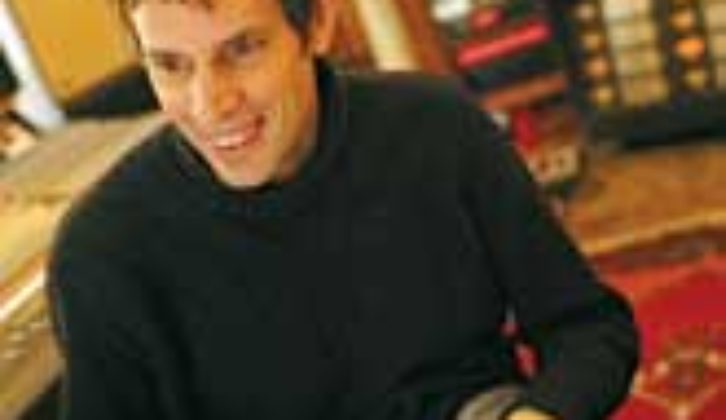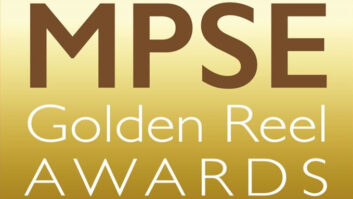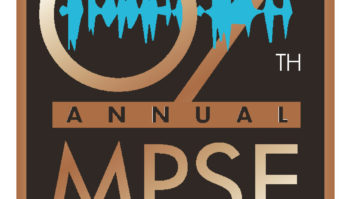

Photo: Luther Salom
For many years, Ontario-born Malcolm Burn has been joined at the hip (so to speak) with fellow Canadian producer/musician Daniel Lanois. He played on, engineered or mixed (or all of the above) some of Lanois’ greatest productions, including Bob Dylan’s Oh Mercy, Peter Gabriel’s Us, the Neville Brothers’ Yellow Moon, Emmylou Harris’ Wrecking Ball and Lanois’ own masterful debut album, Acadie. In turn, Lanois has appeared on a host of albums produced by Burn, including the Nevilles’ Brother’s Keeper, Chris Whitley’s Living With the Law and Harris’ recent masterpiece, Stumble Into Grace. The two share a love for great songwriting and adventurous sonics, including the wonderfully musical atmospherics, creatively employed effects and unusual instrumental colors that give their productions a distinct feeling and sound.
On his own, Burn has also helmed releases by the likes of Lisa Germano (Happiness), John Mellencamp (Human Wheels), Iggy Pop (American Caesar), Shawn Colvin (Sunny Came Home), Midnight Oil (Breathe), Patti Smith (Gone Again) and many others. When we caught up with Burn at his Ulster County, N.Y., home, he’d just finished a project in England with a British rock band called Grand Drive and was working with Luthea Salom, a talented singer/songwriter. This summer, he’s cutting another album with Whitley, this time in Dresden, Germany. And long-term, Burn is working on a second solo album. Though he’s happy to talk about production, Burn notes, “I want to stress that I am a musician and a songwriter myself, even though I produce and engineer records. To me, that’s part of being an artist, and I consider the recording studio sort of a workshop for sonic creativity first and foremost.” Duly noted.
How and when did you and Daniel Lanois become fellow travelers? Obviously, you guys share a certain aesthetic or something.
It must be in the water, eh? [Laughs] In the early ’80s, I had this band in Toronto called Boys Brigade, which was sort of post-punk. This was the New Romantic era — Duran Duran and all that. U2 was another big influence at that time. I was also really interested in these records that were coming out by this group called Material, with Bill Laswell and Michael Bienhorn. They were combining funk with African influences and pure kick-ass rock ‘n’ roll guitar. So that was a major influence on me.
Another guy I really liked a lot was Brian Eno. I’d been listening to him for a while and was just really struck by his creative approach. I remember I used to read these keyboard magazines, and one month, it would be Rick Wakeman [of Yes] on the cover and the next it would be Keith Emerson [of E.L.P.]; all the prog rock guys, which I really couldn’t stand. Anyway, one month they had a story on Brian Eno and they asked him about what keyboards he uses, and he said, “Well, I’ve only got two, and one is this Elka or something that tends to forget the programs and rewrites them, and every time I turn it on, I’ve got a bunch of new sounds, but for me, that’s really interesting.” That was one of the things that made me take a keen interest in what motivated people to do what they do and express themselves in their own way instead of just emulating others.
At some point, I heard that Eno was hanging around in Hamilton with Dan [Lanois] at Dan’s studio — which he and his brother Bob had — called Grant Avenue. So I became quite keen to work with Dan because of the Eno connection. When my band started to get popular down in Toronto, Dan’s girlfriend brought him to see us. Unfortunately, it was a terrible gig, just awful; one of those nights when nothing worked. But I guess Dan liked it enough that he then requested a meeting with the band. So we met with him and he was really quiet. Then one of the guys in the band and our so-called manager at the time went down to see Dan’s studio. They came back and said, “Oh, this Lanois guy’s not goin’ anywhere. It’s kind of a Mickey Mouse studio. Who wants to make a record down there? They don’t have that much equipment. We want to work with someone famous.” I was young and believed that bands were democracies and the decision was made to work with Geddy Lee [of Rush] instead. Geddy was a great guy and he worked really hard and made a good record for us. It was all part of the business situation.
So a few years passed. Dan, instead of making our record, worked with a band called the Parachute Club and made a pretty successful record for them. I think it was a Top 10 record [in Canada]. He also worked with Martha & The Muffins and did well with that. Years later, as it turned out, I was dating Dan’s sister Jocelyn and he came to pick me up at the bus station. I hadn’t seen him for five or six years at this point. In the meantime, he’d worked with U2 and done Peter Gabriel’s record So. He was doing pretty well. And he shows up and the first thing he said to me is, “So, you never called me back.” “Yeah, I know.” “You f***ed up.” And we both laughed. He said, “Rodney Dangerfield should have produced your record. At least you would have had a few laughs.” So that’s how we became re-acquainted.
How did you start actually working with him?
I had been recording a bunch of stuff in my bedroom on a little TEAC 4-track Portastudio. My attitude is if you can make a good cassette copy, you can make a great record because that’s where it all starts: that idea of having a pretty limited format and making the most of it. And I really made so much of it. I would record back-and-forth on three tracks [of the Portastudio] and keep submixing and submixing and then eventually I’d do a stereo premix to a 2-track reel-to-reel that I had and then I’d bounce back to two tracks. While I was bouncing it, I’d do some more overdubs. I got pretty good at it.
Hey, it worked for The Beatles.
Right. And I didn’t realize that what I was doing was the exact same thing Les Paul had done. [Laughs] He would record the instruments that required the least fidelity first, so in the degenerative process, you had a bass sound that still sounded like bass, whereas if you needed an acoustic guitar or a vocal that needed more fidelity, you did those last.
Anyway, I was using fairly primitive stuff to record with, and one day I said to Dan, “Look, I’ve been working on this stuff and I think it sounds really good, but I’d love to hear what you think.” I didn’t tell him I’d recorded it in my bedroom or anything. So he listened to it and he said, “That’s a great sound! We’ve been trying to get a guitar sound like that for The Edge [guitarist of U2] and we haven’t been able to. What are you doing up there?” So I said, “Well, I’m using my little Tom Scholtz Rockman and my Stratocaster up in my bedroom.” He was pretty impressed. And we started working together shortly after that. We worked on Acadie and some other things.
It always struck me as being a pretty casual division of labor on the projects you did together. You both play, you both know the equipment. What was it like on Dylan’s Oh Mercy for instance?
Dan wanted somebody in there who wasn’t just a knob-turner. He wanted somebody who could set everything up, but could also grab an instrument and play along and have a more musical picture rather than some technocratic operative. In terms of that record, there was a good balance between Dan and Bob [Dylan] and myself. Bob and Dan were kind of equal on a certain level, and I was a more neutral third party to sort of balance things out.
Were you awed by Dylan?
A little, as a songwriter, of course. We caught him at a very good time. He had sort of been rejuvenated by the success of the Traveling Wilburys record. I think that made him feel like he was still relevant and had some things to say. And I’ll tell you what — he’s a damn hard worker. There are few people I’ve worked with in the studio who work as hard at their craft as he does.
Even though he’s sort of famous for being Mr. First Take?
That’s not necessarily true. What he does — or at least on that particular record and on the Time Out of Mind record, as well — is he’ll keep searching for the arrangement he likes: faster, slower or 4/4. Should there be piano or guitar; this key or that key? And you’re trying to follow him. But by the time he’s decided all that, it goes pretty quickly because he’s satisfied.
I’ve got some really interesting recordings of him — which I’ll never divulge — sitting there playing the song “Most of the Time” and saying, “I can do this song this way or this way or this way,” and each time he plays it, it’s like a completely different song. He does a sort of ‘Bob at the Newport Folk Festival’ way, then he does a grungy electric version and then he does a blues version. The lyrics probably aren’t going to change much, but everything else is negotiable.
Another album you and Lanois worked on that really knocked me out was the Neville Brothers’ Yellow Moon. It’s so unlike their other records.
Yeah, that’s true. I really wanted to work on Yellow Moon, but I was really nervous going into that record because I thought, “Shit, I don’t know how to record drums. I don’t know what to do.” [Laughs] Then the first day, Dan says, “By the way, I don’t want any drums on this record.” “Great! You’ve come to the right guy.” [Laughs] So everything was done with hand percussion, which was great. It’s so much a part of the sound of that record. Instead of drums, the bass is right up front and it’s really the driving instrument.
What an amazing thing to do with a band that’s famous for it’s second-line drumming. Obviously, there’s a level of trust, cooperation and collaboration you guys are able to engender that allows the people you work with to get out of their conventional thinking, too.
With the Nevilles, I think they trusted us and thought that we knew what we were doing for some reason. We’d be in there playing with them and coming up with ideas together. They were very open to trying something different.
The biggest problem I have when I work with an artist is trying to stay out of the corn patch.
The corn patch?
The corn patch is the place you go where cornball ideas take hold — you gotta stay out of the corn patch! Bands will quickly fall into the corn patch. Basically, they want to give the people what they want. They have to survive. And people like that have a corny side.
Recently, on this song Grand Drive was doing, I thought, “Oh my God, if we do this song the way it’s written, it’s going to sound like a cheesy ballad from 1985 and I don’t want to go there.” I don’t even know how to go there; I have no idea how to do a big rock ballad. So the band started playing the track and with tons of enthusiasm, I said, “Guys, I think I have another idea for this track and I’m really convinced it’s going to be fantastic. It’s going to be transcendental by the time we’re done with it.” And I gave them a very convincing and enthusiastic picture of what I wanted to do. And at the end, they went, “Oh, okay.” The song is called “I Believe In Love.”
Yikes! Wasn’t that on a Foreigner album or something?
[Laughs] Actually, it’s a really good song. There’s nothing wrong with that sentiment, obviously, but you have to do it the right way. So rather than having them go out and play it like a band, which is how we’d been working, this is going to be a complete paint-by-numbers construction job that’s really different. It sort of sounds like U2’s War record. And by doing it that way, the song took on another meaning.
What was the first production you did on your own in which you felt you nailed it?
The first record I ever produced was a record called Red Earth by a band called Crash Vegas, a Canadian band, and I love that record. I love the simplicity of it. It was done on an 8-track, 1-inch Studer machine.
Tell me about working with Emmylou Harris. Daniel produced Wrecking Ball, which you also helped with, and now you’ve produced the last two albums.
Emmylou can work with anyone she wants, and to her credit, when it was suggested she work with a new producer, she wanted to try something different. At the top of her list was Dan because of the Oh Mercy record. A lot of the records she’d liked were ones Dan and I had done together, so it made sense to make me a part of the equation, too. On the Wrecking Ball record, although I didn’t produce it, I was quite involved in the song choices. I was the one who brought in the Neil Young song “Wrecking Ball” and “Every Grain of Sand” by Bob [Dylan]. And I was involved in some of performances and arrangements. The bulk of that record was done at Woodland in Nashville, which is now Dave Rawlings and Gillian Welch’s place.
Then when she was ready to do another record, I think Dan felt as though he didn’t want to go back and try to re-create something we’d already done, so he suggested that I do it, and Emmy was already comfortable with me, so it wasn’t a big step.
And that was done at your former studio in New Orleans.
Most of it was. That studio was sort of like a poor man’s version of Kingsway [Lanois’ New Orleans studio]. It was a funky little house but it had a nice feeling to it and it sounded good. That record was recorded to 2-inch. Most of it was recorded on a Mackie with good microphones and preamps. I couldn’t afford the big API at the time. But I dare anyone to tell me Red Dirt Girl doesn’t sound good.
How did the songs that Emmylou wrote for that record and the new one shape the overall aesthetic? There are lots of effects and compressed parts, odd atmospherics.
A lot of that record was her coming up with the basic idea for the songs and then me creating loopy, groovy things underneath. At that time, I was using an Ensoniq ASR10, which is the Ensoniq version of an MPC 60 — sort of sampler, sequencer, drum machine all in one unit that I became quite clever at. That became the basis of a lot of the tracks on that record. Now if I’m going up that street, I’ll use Reason.
How much of what we hear is room ambience as opposed to processing?
A lot of it; probably more than I would have preferred at the time. [Laughs] Which is probably why the recent record [Stumble Into Grace] is more controlled.
Where was that done?
Two studios in Nashville. One called Masterlink, which used to belong to Al Jolson.
Al Jolson owned a studio in Nashville? Mammy!
It’s still owned by Al Jolson Enterprises. It’s a great place; I highly recommend it. It’s one of the last great dedicated studios. Big room, nice control room, not a lot of bullshit to deal with. It’s got that wood paneling, shag carpet vibe that I love. [Laughs] So a good portion of it was done there and then we also worked at Sound Emporium. My attitude is if I’m going to be in a “normal” big studio, I want the big-ass speakers. I want those big things they’ve got in the wall.
Was Stumble Into Grace recorded to 2-inch?
It was initially recorded onto 2-inch and then, because we had to change location a number of times, we went onto RADAR. I’m a big fan of RADAR. I like the idea of a dedicated recorder: The system only does this. It’s a place to record your music as opposed to record your music, download pornography, play video games and everything else. I’ve never had a problem with RADAR. It sounds great, it’s easy to use. You can still hook it up to Pro Tools for editing if you want. If and when I decide to upgrade the system I’m using at home, it’ll probably be to RADAR.
What do you have at home for recording now?
I have my 2-inch Studer 800 24-track machine. I have Pro Tools; not the HD.
Are there producers out there who impress you currently?
Not really. I hear a lot of producers who are sort of bland versions of me and Dan. What annoys me to no end is this endless lineup of ex-musicians in their 30s and 40s who have decided they can’t make it in the pop world so they want to produce records. I’m not going to name names, but they’re taking my work away! They’re making bland versions of my records and I don’t like it. It’s sort of “lite” whatever. All the interesting stuff has been extracted and you’re left with this — nothing. You take out anything that will challenge anyone and leave the remnants. That’s not something that’s going to make me want to go out and buy a record.


